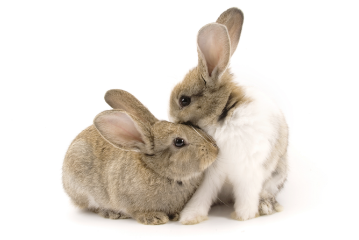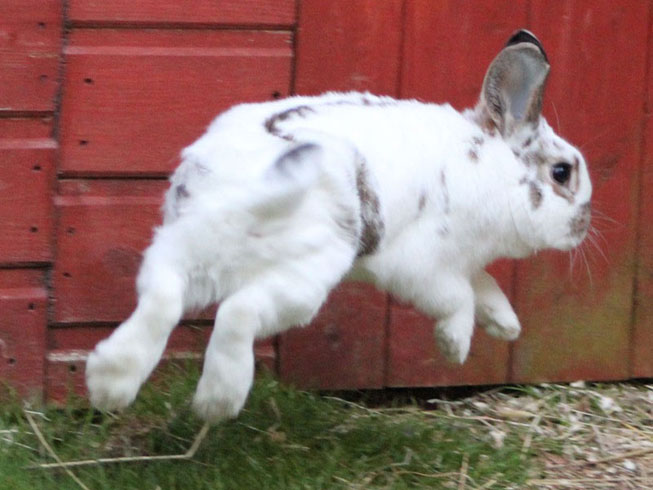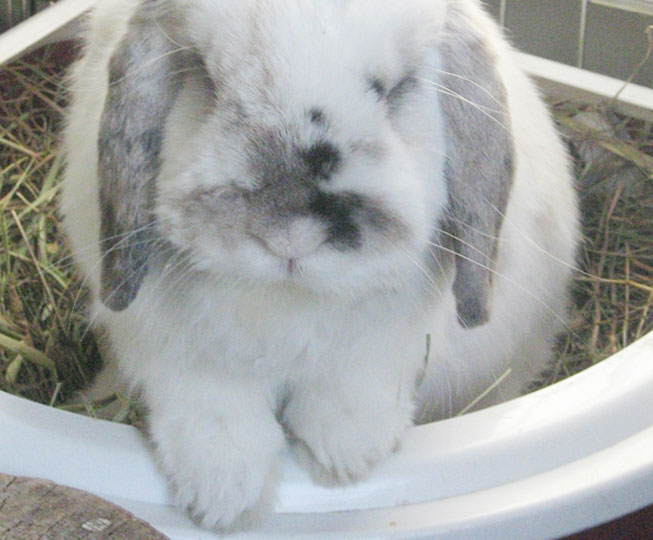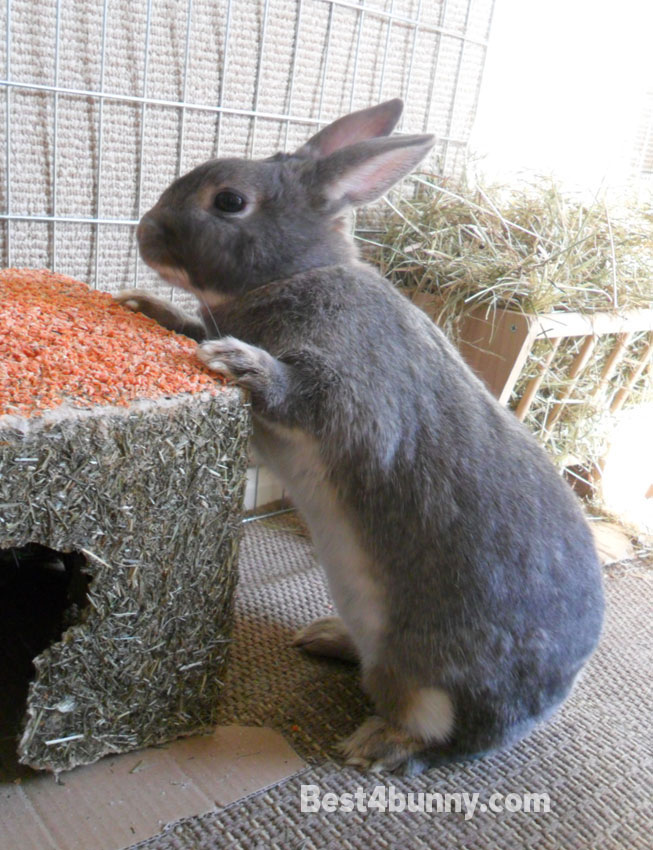Knowing your rabbits are happy is the most important thing. Bunnies have great personalities just like a cat or dog and every single one is different. They are very inquisitive, clever, mischievous, loyal and loving creatures. The key to a happy bunny is giving them the best care and accommodation. Learn to understand your rabbits behaviour and you will learn so much yourself.

In this section
Did you know?
- Bunnies are very easy to toilet train
- Bunnies hate being picked up
- Bunnies love routine
- Bunnies have moods & sulk too
- Bunnies love to stretch out and relax
- Bunnies love investigating
- Bunnies need to stimulate their minds
- Bunnies get bored & can get depressed
- Bunnies will learn to trust you
- Bunnies will learn commands just like a dog
- Bunnies can learn when it is feeding time or exercise time and they will be waiting for you.
- Bunnies will give you a friendly nudge which is their way of saying ‘hello’ or maybe even ‘thank you’.
- Bunnies are sociable animals and hate to live alone.
- Bunnies can snuggle up to you and love to be fussed. Nose rubs are a favourite.
- Bunnies can learn little tricks to test your patience, like refusing to go in their bedroom area at night time and giving you the run around for a while.
- Bunnies can be just like a child and want to play with things they are not supposed to or go in areas they know are out of bounds the minute your back is turned.
- Bunnies love to sunbathe – but make sure they are not stuck in the sunlight and that they can move into shade also.
- Bunnies hate strong smells like perfume and smoke.
- Bunnies don’t like other animal smells (They will think there is a predator close by and will probably thump their back legs. So wash your hands and maybe even change your clothes if you have been around other people’s pets).
[adsanity align=’alignnone’ id=63]
Body Language
Blinkys

This is when your bunny jumps and twists in the air and runs at fast speed in different directions (something all rabbits should have the space to do!) Very funny to watch and will always make you smile and you should feel proud you are witnessing this as your bunny is very happy.
Happy bunny flops
All of a sudden your bunny will from standing flip on to their side and it looks like they are fast asleep. This means your bunny is very happy and relaxed.
Scenting with their chins
Bunnies are very territorial animals and will mark objects by rubbing their chin on everything in their area to mark their territory. Every time you see your bunny doing this its a bit like them saying ‘That’s mine, and that’s mine and that’s mine’.
Tail up in the air and ears forward
Means they have sensed danger nearby.
Tail up and ears back
They are about to attack/bite as they feel threatened
Eyes bulging
Means your bunny is terrified.
Chattering their teeth quietly
This is the equivalent to a cat purring and you will usually witness this when you are stroking them.
Loud chattering/grating of teeth
Means they are in pain. See your vet asap
Sitting or hiding in a corner for long periods of time
Means they are unwell. See your vet asap.
Screaming
When you hear a rabbit scream it means they have sensed extreme danger or they are in a huge amount of pain & if they are that scared to scream there is a high risk of them having a heart attack.
Training Bunny
Litter training
Litter trays come in all shapes and sizes, but the bigger the tray the more hay you can put in to encourage your rabbit to eat hay while they poop. Seed trays and drip trays can be ideal as they do come in big sizes and all kinds of shapes and are cheaper to buy than some actual litter trays.
By using sawdust or Megazorb to line the tray helps absorb more urine and reduces odours too. Cover well with hay.
Use a mix of white wine vinegar and water to clean the trays.
Litter training rabbits can be simple.
Check where your bunny is going to the loo in his accommodation. Then place a litter tray in this area with some soiled hay in the tray. Keep placing soiled hay/droppings into the tray and in no time at all your bunny should get the message that this is their toilet. If they insist on going elsewhere provide them with more than one litter tray and place in the areas they go. Who said a rabbit can’t have more than one loo!
Sometimes you will probably see the odd little pile of droppings in a place you haven’t seen them before or you may come across some around the outside of a room. This can just mean your rabbit is marking his/her territory so don’t assume straight away they need a litter tray there now or that they are failing their litter training.

Bunny proofing
When training your rabbit whether it be indoors or outdoors, please remember that most of the time what your bunny is doing is natural behaviour to them. Never hit or shout at your rabbit. You need to try and discipline them in a firm, calm collective way and not stress them out. It will help to decide beforehand what areas (inside and out) are ok and safe and what areas are to be out of bounds.
Teaching them ‘No’
When teaching them ‘No’ you can clap your hands (not too loudly) and say ‘no’ quite loudly and firmly, don’t shout though. Say their name a lot too. You can use a bell or rattle to get their attention or you can use a plant spray set on mist spray to help discipline them. They do soon learn. Remember to praise them too when they do obey you.
PLEASE NOTE: Never leave them unsupervised when they are exercising free range.
Free range exercise in the garden
Gradually increase the exercise area as this will help your rabbit to know where to go when it’s time to go back in. Never leave your bunny in the garden alone. Always supervise their free range exercise time.
If you have large areas of garden or flower beds that are out of bounds, consider a metal play pen unfolded to separate off this area easily.Puppy pens cover a large area when unfolded but just make sure they are secure and can’t fall over.
Getting them out of no go areas – a long object such as a cane or sweeping brush to guide them out gently comes in handy when you can’t reach them yourself.
Always make sure your garden has nowhere your rabbit could escape to or get into danger:
- Ponds – make sure they are covered.
- Gaps under or at the side of garden gates – Cover with a sheet of galvanised mesh wire and fold into gaps and attach with cable ties.
- Gaps under fencing – place bricks or concrete slabs.
- Toxic plants – corner these areas off.
Time to go back in
When it comes to go back in use the word ‘bedtime’ or ‘bed’ and they will soon associate this word with going back in.
Every day will be different. Some days they will go straight back in and other days will be a challenge as every bunny will give you the runaround at some stage!
Indoors and house proofing
The easiest thing is to move things out of reach from your rabbit if you don’t want them to investigate them. Tv remote controls, ornaments, books and photo frames are just a few things to move out of reach. Also house plants as they could be toxic to your rabbit. Even if they are not toxic, you will no doubt find them either toppled over or the soil rearranged over the floor at one time or another.
Always provide plenty of safe fun alternatives to distract your rabbit. Its no good distracting them from something and they have nothing else to go to as they will just keep trying. Remember to praise them when they do go to the safe alternative.
See Boredom Busters for ideas on safe, fun alternative toys to create.
Make sure furniture has no tight small gaps where your rabbit could become stuck. Move furniture to cover electrical cables or use plastic casing to cover exposed wires.

To block gaps to no go areas, if possible, move the furniture together. Sometimes your rabbit may just go at the furniture because a gap is not big enough to get through. If it is a gap you are happy for the rabbit to get into and it is safe, then consider moving the furniture so the gap is wider. You will probably find your rabbit won’t go at the furniture anymore.
Rabbits love sitting behind sofas and exploring the edges of rooms. Take time to watch your rabbit and get ready to say ‘no’ when they go to chew something they shouldn’t. Keep doing this until they no longer show interest.
New items of furniture will always need to be investigated by your bunny. They will want to scent it. Watch over them, allow them to scent it and get ready to say ‘no’ if they go to chew it.
Always take care with reclining furniture or pull out sofa beds etc as these can be dangerous if your rabbit gets caught up in them and you are unaware they are there.
[adsanity align=’alignnone’ id=63]
Natural Behaviour
Daily routines
They are most active early morning and evening so make sure this is the time they have their exercise and all the toys they need to keep their minds active. 5am is the usual time a bunny will be awake to start grazing. So even though you probably won’t be up, make sure your bunny has fresh hay the night before to allow for this early morning grazing. They sleep during the day so make sure they have an area that allows them to have the peace and quiet they need. They can also use this area to hide in when they feel unsafe or threatened.
They love cleanliness
Bunnies are very clean animals so make sure their accommodation is clean too. If you wouldn’t like to sit or lay on what they sit or lay on then don’t expect it to be acceptable for your bunny.
The cutest thing is watching your bunny clean themselves. It can look like they are saying their prayers when cleaning & wetting their front paws.
Dealing with aggression
If you come across aggression in your rabbit then its because he/she is unhappy or feels threatened.If your rabbit is showing signs of sudden aggression that is not normal behaviour then it could be because they are ill or in pain. Have your vet check them asap.
Most rabbits that have been neglected or had a history of bad upbringing will be shy and nervous. They will be likely to show aggression as this would be their way to protect themselves. With lots of patience and time you can teach the bunny to learn to trust humans again and the aggression should be a thing of the past.
Rabbits hate being picked up! This is because they are prey animals and it makes them feel unsafe and vulnerable. It is always best to fuss & play with them while they are on the floor.
Learn to gain their trust slowly. Let them come to you. Sit with a treat in your hand and be patient. If your bunny doesn’t come to get the treat then leave the treat where you was sitting when you leave.
Talk to your rabbit in a nice soft voice and watch their ears move. He may not be facing you and not showing an interest, but if his ears are moving he is secretly listening.

